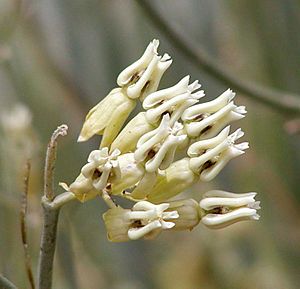Asclepias subulata facts for kids
Quick facts for kids Asclepias subulata |
|
|---|---|
 |
|
| Scientific classification | |
| Genus: |
Asclepias
|
| Species: |
subulata
|
Asclepias subulata, also known as the rush milkweed or desert milkweed, is a unique plant found in the deserts of the United States and Mexico. It's a type of milkweed, but it looks quite different from many other milkweeds you might know. This plant is special because it often loses its leaves early, leaving behind a bunch of bare, upright stems.
Contents
Discovering the Desert Milkweed
What Does it Look Like?
The rush milkweed is an herb that stands tall and lives for many years. It often loses its leaves early in the growing season. This leaves it looking like a group of bare, upright stems.
At the top of these stems, you'll find groups of special flowers. Each flower is a creamy white color. It has parts that bend backward, showing the inside. Here, you can see five shiny columns, each with a tiny hook at the top.
After the flowers, the plant grows a fruit called a follicle. This fruit looks like a small pouch. Inside, it holds many flat, oval seeds. Each seed has long, silky, hair-like plumes. These plumes help the seeds float away in the wind.
Where Does it Grow?
This interesting milkweed plant is native to the desert areas of the southwestern United States. You can find it in places like Arizona, Nevada, and the desert regions of California. It also grows in northern Mexico. It thrives in dry, sunny desert environments.
A Plant with a Special Use
Did you know that this plant was once studied for a very practical purpose? In 1935, scientists in Bard, California, looked into whether the rush milkweed could be a source of natural rubber. Natural rubber is a useful material that comes from plants. It is used to make many things, like tires and elastic bands.
See also
 In Spanish: Asclepias subulata para niños
In Spanish: Asclepias subulata para niños

